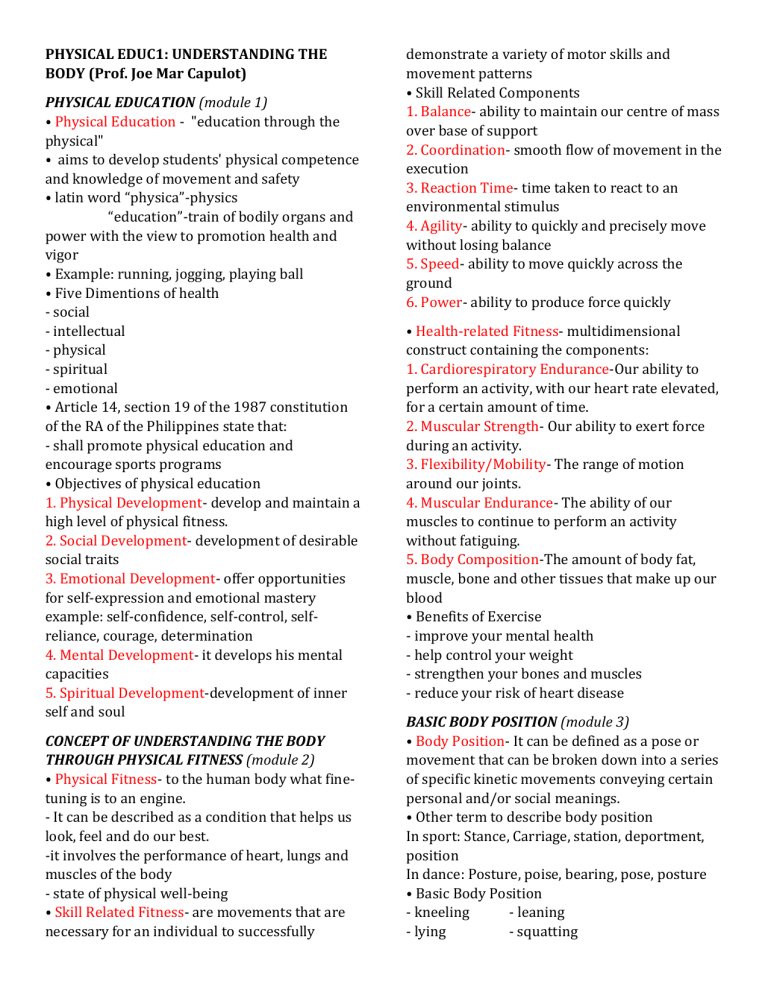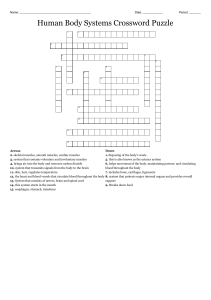
PHYSICAL EDUC1: UNDERSTANDING THE BODY (Prof. Joe Mar Capulot) PHYSICAL EDUCATION (module 1) ⦁ Physical Education - "education through the physical" ⦁ aims to develop students' physical competence and knowledge of movement and safety ⦁ latin word “physica”-physics “education”-train of bodily organs and power with the view to promotion health and vigor ⦁ Example: running, jogging, playing ball ⦁ Five Dimentions of health - social - intellectual - physical - spiritual - emotional ⦁ Article 14, section 19 of the 1987 constitution of the RA of the Philippines state that: - shall promote physical education and encourage sports programs ⦁ Objectives of physical education 1. Physical Development- develop and maintain a high level of physical fitness. 2. Social Development- development of desirable social traits 3. Emotional Development- offer opportunities for self-expression and emotional mastery example: self-confidence, self-control, selfreliance, courage, determination 4. Mental Development- it develops his mental capacities 5. Spiritual Development-development of inner self and soul CONCEPT OF UNDERSTANDING THE BODY THROUGH PHYSICAL FITNESS (module 2) ⦁ Physical Fitness- to the human body what finetuning is to an engine. - It can be described as a condition that helps us look, feel and do our best. -it involves the performance of heart, lungs and muscles of the body - state of physical well-being ⦁ Skill Related Fitness- are movements that are necessary for an individual to successfully demonstrate a variety of motor skills and movement patterns ⦁ Skill Related Components 1. Balance- ability to maintain our centre of mass over base of support 2. Coordination- smooth flow of movement in the execution 3. Reaction Time- time taken to react to an environmental stimulus 4. Agility- ability to quickly and precisely move without losing balance 5. Speed- ability to move quickly across the ground 6. Power- ability to produce force quickly ⦁ Health-related Fitness- multidimensional construct containing the components: 1. Cardiorespiratory Endurance-Our ability to perform an activity, with our heart rate elevated, for a certain amount of time. 2. Muscular Strength- Our ability to exert force during an activity. 3. Flexibility/Mobility- The range of motion around our joints. 4. Muscular Endurance- The ability of our muscles to continue to perform an activity without fatiguing. 5. Body Composition-The amount of body fat, muscle, bone and other tissues that make up our blood ⦁ Benefits of Exercise - improve your mental health - help control your weight - strengthen your bones and muscles - reduce your risk of heart disease BASIC BODY POSITION (module 3) ⦁ Body Position- It can be defined as a pose or movement that can be broken down into a series of specific kinetic movements conveying certain personal and/or social meanings. ⦁ Other term to describe body position In sport: Stance, Carriage, station, deportment, position In dance: Posture, poise, bearing, pose, posture ⦁ Basic Body Position - kneeling - leaning - lying - squatting - slouching - sitting - crouching - standing ⦁ Standing - orthostatic - position and supported only by feet ⦁ Kneeling - one/both knees touch the ground - Kneeling when only composed of one knee, and not both, is called genuflection ⦁ Sitting - action and resting position in which the body weight is supported - bony ischial tuberosities with the buttocks in contact with the ground or a horizontal surface ⦁ Lying - body is more or less horizontal and supported along its length by the surface underneath TYPES OF MOVEMENT (module 4) ⦁ Movement- change in the position of a body part with respect to the whole body - ex: eyes blinking, breathing, eating ⦁ Types of Movement ⦁ Locomotor- movement is a type of movement in which the body travels through space from one location to another location. ⦁ Basic Locomotor movement: walk, jump, leap, skip, slide, crab walk, run, gallop, hop, pencil roll ⦁ Non Locomotor- movement also called an axial movement, is anchored movement that takes place about the body's axis or the spine. ⦁ Basic Non Locomotor movement: balance, bend, curl, pull, push, stretch, sway, swing, turn, twist CONDITIONING EXERCISES FOR THE BODY (module 5) ⦁ Body Conditioning- exercises target your whole body, using lots of different muscles to strengthen, shape, and tone your body. - They may combine several types of exercise, such as flexibility, strength, and resistance training. ⦁ Extremities - farthest or most remote part, section, or point the island's westernmost extremity ⦁ Upper Extremities - or arm is a functional unit of the upper body. It consists of three sections, the upper arm, forearm, and hand. ⦁ Lower Extremities - part of the body from the hip to the toes

